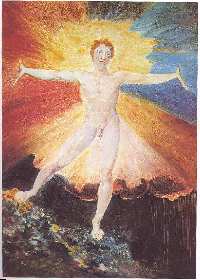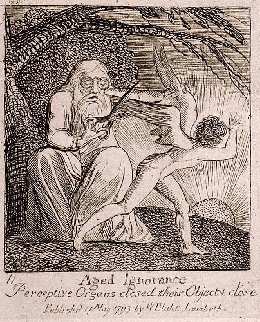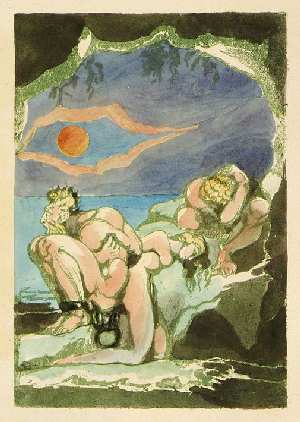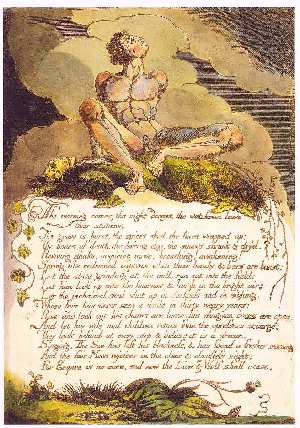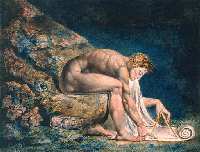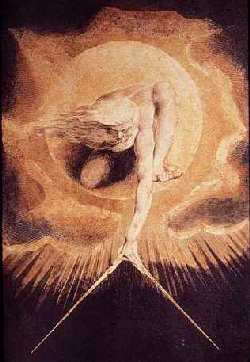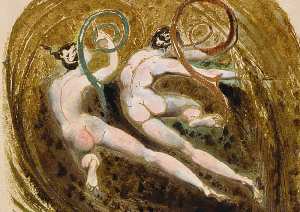 |
||||
|
William Blake's EcofeminismMale Ecofeminism? By Charles Moffat - 2001.
[Right] Albion Descending the Mountain. During the Romanticist art period and the start of the industrial revolution, William Blake was one of a scant few artists with both gender equality and the environment on his mind. While the French revolution raged on, he hoped for a British revolution which never came. The Enlightenment came and went, and Thomas Paine's "The Rights of Man" was considered to be THE book of the times. Mary Wollstonecraft's "The Vindication of the Rights of Woman" sparked a new era of feminism that would later reach its peak in the British suffragettes movement. Both Thomas Paine and Mary Wollstonecraft were friends of William Blake. He did the illustrations in both of the above books.
[Right] Blake believed it was the ignorance of the older generation that socially conditions children to become a specific gender role. He saw this as chopping off their wings and their sexual freedom. He married Catherine Boucher, but they never had any children, and his frequent writings and poetry about sexual freedom suggest there was something hidden. Here's my theory: Catherine and William were in a "Johnny and Betty" relationship... Johnny and Betty who? Well if you're familiar with Meryn Cadell, its a song about a gay and lesbian couple who get married just so they will fit in. KA-CHING!!! But is it possible? Well maybe. It might be more likely that they were both bisexual. I can't really prove it, but at the same time you can't really prove he was straight. At the very least we could say he was bi-curious. Some of Blake's allegorical books were: Songs of Innocence, Songs of Experience, The Marriage of Heaven and Hell, Visions of the Daughters of Albion, & The Book of Thel. His most famous poem "The Tyger" was part of Songs of Innocence. "New Jerusalem" is his most famous song, which is practically a national anthem in Britain, which is ironic because it urged people to revolt and create a new nation.
[Right] The rapist/slaver Bromion and Oothoon chained to each other while Oothoon's lover cowers in a fetal position. Albion is of special interest. A giant naked man who likes to dance in the wilderness. He is the representative incarnation of Britain of old (Albion is the ancient Basque/Welsh name for Britain), and his daughters are the women of Britain. Because they were all allegorical characters, it takes a certain level of intelligence and interest to understand Blake's works. One of Albion's daughters is tied up to a rapist in a poetic story, which is representative of society's treatment of both sexes in which all men are treated as potential rapists and women are treated as the 'frail seductresses' trapped in a position they do not want, when in reality they are equally as strong and willful as men. The rapist and Oothoon (one of Albion's daughters) are also representative of slavery of both men and women. William Blake was intensely interested with the emancipation of slavery. The cave they are locked up in has also been suggested to be representative of the "rape of the natural world" (according to Hutchings). The rape and enslavement of nature and sexuality. Since the eighteenth century, the word "rape" has often been used to describe human acts of environmental plunder and destruction, a terminological employment that suggests, as ecofeminist writer Susan Griffin observes, "a profound connection between the social construction of nature and the social construction of woman".
[Right] Blake's poem about the emancipation of slavery and sexuality. In Visions, Blake further complicates this equation of sexual and environmental violence by considering it in light of a colonialist racism that enslaves non-Europeans, forcing them to become the very instruments of environmental subjugation in the New World. Thus, when the rapist Bromion brags of his slaves that "They are obedient, they resist not," his grammatically ambiguous plural pronouns can be seen to gesture not only toward the antecedent "swarthy children of the sun" but also toward the "soft" or pliable landscapes he expropriates in the previous line. Bromion seems to think he is master of both the landscape and the people in it. Avalon, the topic of Michelle Malone's feminist song of an idyllic refuge from society's prejudices and sexism and war. It is a more modern variation of William Blake's allegorical writings. In context, Avalon is the utopia of sexual/gender freedom where characters such as Albion, Thel, Oothoon and his other daughters would find freedom. Except Blake does not write about Avalon. He is more concerned with the people and the metaphorical situations that represent people in society. Avalon, Utopia, Eden, New Jerusalem. In Avalon and Eden, the people don't control the landscape. They belong to it. But in New Jerusalem the opposite is true.
[Right] Sir Isaac Newton. For Blake, New Jerusalem was a conceptualized place of the future. A new city that could be built and perfected over the ruins of the old. Whether it could be built environmentally friendly was unclear. Knowing Blake's idealized visions, New Jerusalem would be a melding of the Garden of Eden with an utopian city.
The city and its high technological pursuit of Newtonian science was something that upset Blake. He recognized Newtonian science as being controlled by mathematical equations, and that the people who used it were using it to make a profit. Economists and scientists built upon Sir Isaac Newton's formulas and created the industrial/business revolution. The rape of the landscape was something Blake predicted in his visions. [Right] The Newtonian God. Across from Blake's home in London was a factory. From this he created a sketch of what an entire landscape of factories and their destruction of the landscape would be like. Right down to the towering smokestacks and sewage waste. A prophetical image to say the least. The factory later burnt down, mysteriously and Blake moved to the more rural Lambeth in 1790. Blake practically made his own religion. The allegorical stories of Albion, Thel, Oothoon and the numerous books on topics that varied from religion, sexuality, the environment, imagination, freedom, and love made many volumes that in total rivalled the thickness of a Bible. Indeed, the names of his books often were similar to the names of books in the Bible. His visions of angels and spirits told him that the priests of the church were following a corrupted version of god. This corrupted version was a mathematical/Newtonian god. Blake saw the Newtonian god as an abomination because it was impartial and thoughtless, more like a machine. It was a god without humanity.
[Above] Sexual Freedom for Both Sexes.
More Sites about William Blake:
|
|
|||
|
|
||||
|
|
||||
 |
|
 |
||
